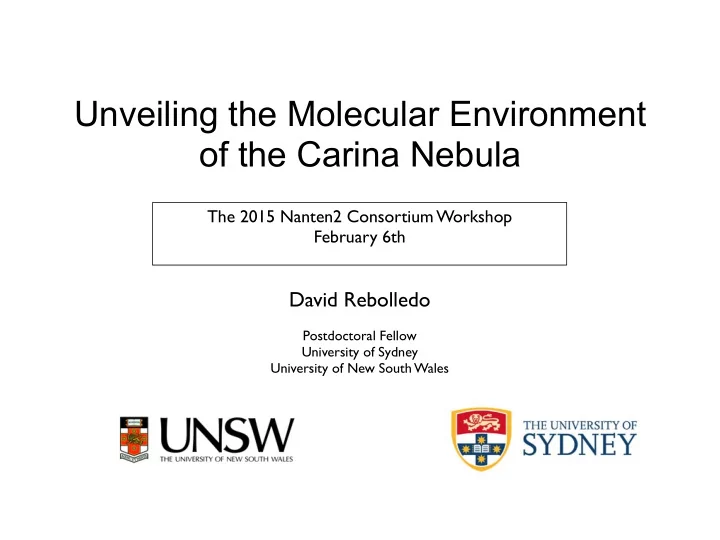

Unveiling the Molecular Environment of the Carina Nebula The 2015 Nanten2 Consortium Workshop February 6th David Rebolledo Postdoctoral Fellow University of Sydney University of New South Wales
Motivation a b 0:30 • The Carina Nebula is one 0:00 of the nearest regions of active star formation. -0:30 Galactic Latitude NGC3324 • Located at 2.3 kpc, it is -1:00 the nearest extreme star formation region. -1:30 • Excellent place for -2:00 studying clustered star Parkes [O III ] 3.4 cm H α formation, stellar -2:30 continuum [S II ] feedback and triggered 287 286 287 286 star formation. 288 288 Galactic Longitude Galactic Longitude b- Huchtmeier & Day (1975) a- Smith et al. (2000)
• Previously considered as as an evolved HII region with no current star formation activity. • However, infrared observations revealed several candidates for sites of current star formation. • Those compact infrared sources are located at the heads of dust pillars or dark globules behind ionization fronts • Recent high resolution surveys at X-rays, optical and infrared wavelengths. However, radio has been absent.
A fast visit to Mopra ...
CO Survey of Carina with Mopra Back in 2014 ...
CO Survey of Carina with Mopra Today! 8.5 deg 2
CO Survey of Carina with Mopra 12 CO(1 → 0)
CO Survey of Carina with Mopra 13 CO(1 → 0)
SED fitting Herschel 500 µ m Hi-Gal* (Molinari et al. 2010) 70 µ m 160 µ m 250 µ m 350 µ m 500 µ m * The Herschel Infrared Galactic Plane Survey
F ν = Ω B ν ( T cold )(1 − e − τ ν ) T cold τ ν = τ 0 ( ν/ν 0 ) β ν 0 β = 2 τ 0 = 1 Dust opacity κ ν Dust to gas ratio R DG M gas
K T cold
HI integrated intensity McClure-Griffiths et al. (2005) The Southern Galactic Plane Survey (SGPS) K km s − 1 N HI � atoms / cm 2 = 1 . 82 × 10 18 M HI T B dv
12 CO integrated intensity M H2 � L CO � � X CO � = 4 . 4 K km s − 1 pc 2 2 × 10 20 cm − 2 / (K km s − 1 ) M sun
vs. M H2+HI M gas log( M HI + M H2 ) M sun log( M gas ) M sun
� cm − 2 / (K km s − 1 ) X CO � X CO = M gas − M HI log F CO log( M gas ) M sun
Summary With Mopra Telescope, we have mapped 12 CO and 13 CO over 8.5 deg 2 across the Carina Nebula. I fit Herschel SEDs of each pixel with a modified blackbody to obtain the temperature of the cold gas in the central part of the Nebula. Under the current assumptions, I found that atomic + molecular hydrogen mass overestimates the gas mass provided by the SEDs analysis. X co factor is one order of magnitude smaller than the value commonly assumed. Range is about two orders of magnitude.
Recommend
More recommend